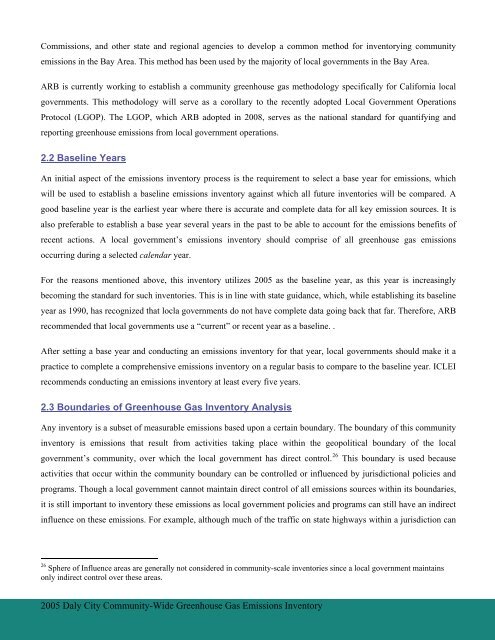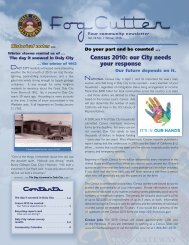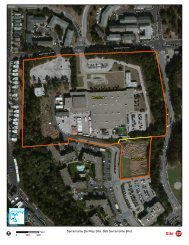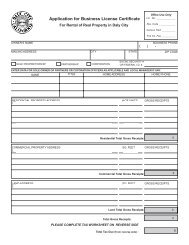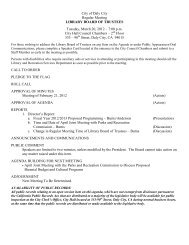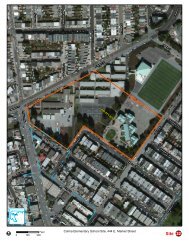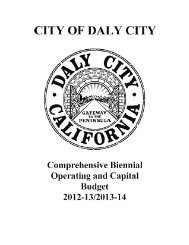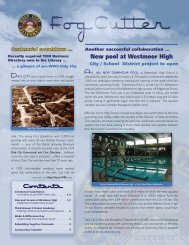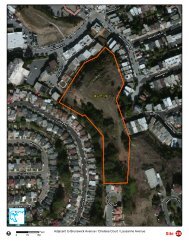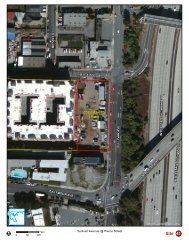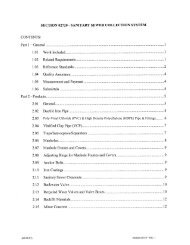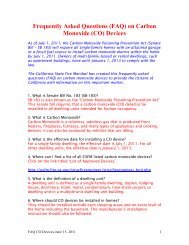Daly City's Green Vision - City of Daly City
Daly City's Green Vision - City of Daly City
Daly City's Green Vision - City of Daly City
You also want an ePaper? Increase the reach of your titles
YUMPU automatically turns print PDFs into web optimized ePapers that Google loves.
Commissions, and other state and regional agencies to develop a common method for inventorying community<br />
emissions in the Bay Area. This method has been used by the majority <strong>of</strong> local governments in the Bay Area.<br />
ARB is currently working to establish a community greenhouse gas methodology specifically for California local<br />
governments. This methodology will serve as a corollary to the recently adopted Local Government Operations<br />
Protocol (LGOP). The LGOP, which ARB adopted in 2008, serves as the national standard for quantifying and<br />
reporting greenhouse emissions from local government operations.<br />
2.2 Baseline Years<br />
An initial aspect <strong>of</strong> the emissions inventory process is the requirement to select a base year for emissions, which<br />
will be used to establish a baseline emissions inventory against which all future inventories will be compared. A<br />
good baseline year is the earliest year where there is accurate and complete data for all key emission sources. It is<br />
also preferable to establish a base year several years in the past to be able to account for the emissions benefits <strong>of</strong><br />
recent actions. A local government’s emissions inventory should comprise <strong>of</strong> all greenhouse gas emissions<br />
occurring during a selected calendar year.<br />
For the reasons mentioned above, this inventory utilizes 2005 as the baseline year, as this year is increasingly<br />
becoming the standard for such inventories. This is in line with state guidance, which, while establishing its baseline<br />
year as 1990, has recognized that locla governments do not have complete data going back that far. Therefore, ARB<br />
recommended that local governments use a “current” or recent year as a baseline. .<br />
After setting a base year and conducting an emissions inventory for that year, local governments should make it a<br />
practice to complete a comprehensive emissions inventory on a regular basis to compare to the baseline year. ICLEI<br />
recommends conducting an emissions inventory at least every five years.<br />
2.3 Boundaries <strong>of</strong> <strong>Green</strong>house Gas Inventory Analysis<br />
Any inventory is a subset <strong>of</strong> measurable emissions based upon a certain boundary. The boundary <strong>of</strong> this community<br />
inventory is emissions that result from activities taking place within the geopolitical boundary <strong>of</strong> the local<br />
government’s community, over which the local government has direct control. 26 This boundary is used because<br />
activities that occur within the community boundary can be controlled or influenced by jurisdictional policies and<br />
programs. Though a local government cannot maintain direct control <strong>of</strong> all emissions sources within its boundaries,<br />
it is still important to inventory these emissions as local government policies and programs can still have an indirect<br />
influence on these emissions. For example, although much <strong>of</strong> the traffic on state highways within a jurisdiction can<br />
26 Sphere <strong>of</strong> Influence areas are generally not considered in community-scale inventories since a local government maintains<br />
only indirect control over these areas.<br />
2005 <strong>Daly</strong> <strong>City</strong> Community-Wide <strong>Green</strong>house Gas Emissions Inventory


